Unit - 1
Introduction
Q1) Define Business Communication.
A1) The word "communication" comes from the Latin word "communis", which suggests something common. Therefore, communication means sharing common ideas. The meaning of a communication dictionary is to convey and exchange information and share ideas.
It is the process by which two or more people communicate or exchange ideas and concepts between themselves. Consistent with W.H. Newman and C.F. Summer, "Communication is the exchange of facts, ideas, opinions, or feelings between two or more people."
Communication is the process of sending information and understanding from one person to another, or from one unit to another, with the goal of getting a given response from the recipient. Through this process, two or more people exchange ideas and understandings and have a specific effect on the behaviour of others.
This is a two-way channel for sending ideas, feelings, plans, commands, instructions, reports, and suggestions that affect an organization's attitude toward purpose. The communicator's goal is to convey undistorted meaning and ideas. The success of a leader, and therefore a company, depends on the appropriateness of communication.
It is the manager's responsibility to communicate and maintain channels where he can communicate his thoughts and policies to his subordinates and receive explanations of his reactions and problems.
Louis A. Allen defines communication in the following ways:
"Communication is the sum of all the items that one person does when he wants to form an understanding in another's mind. It is a bridge of meaning. It is the scientific and continuation of communicating, listening and understanding. Process is included. "
This definition includes two aspects of communication.
- First, there are facts, feelings, ideas, etc. that are communicated. This means that you need a recipient to communicate.
- Second, the definition emphasizes the comprehension element within the communication process. Understanding can only be shared by someone who understands the destination of the message in the same way that the sender of the message wants him to know.
Therefore, communication involves sending a message, or sending and physically receiving a message. Correct interpretation and understanding of the message are important from the perspective of organizational efficiency. Effective communication itself can be its accurate transmission and reception and its correct understanding.
In their book "Business Communication Today", C. L. Bovee, J. V. Thill, B. E. Schatzman writes: However, communication is only effective if the message is known, and it is effective when it stimulates behavior or encourages the recipient to think in new ways. "
Communication between people to convey personal information, messages, or thoughts is personal communication. However, the exchange of business data, facts, and concepts is sometimes referred to as "business communication." Business communication is communication about commercial activities that propose to provide goods and services to consumers for the purpose of profit.
This is the process by which information, facts, ideas, orders, advice, decisions, etc. are communicated, transmitted, or exchanged between or between people involved in the business. Therefore, communication about trade, law, finance, management, management, etc. of a for-profit company is sometimes called "business communication".
The success of a for-profit company depends heavily on good communication. Effective communication removes obstacles to achieving the goals of a for-profit company. Ineffective communication and communication failures can result in loss of cash, time, energy, opportunities and even business credibility.
In this era of globalization, all for-profit companies, large and small, need proper communication for their existence. Business success depends heavily on communication success.
In an era of speed, complexity and competition, it is very important to send product data to the end consumer. It is impossible for them to contact and purchase a product unless they understand the company's product. Communication plays an important role in this area.
Q2) Explain the characteristics of Business Communication.
A2) Three characteristics of business communication:
Communication that becomes business communication must meet the following conditions.
- Practical
- In fact
- Clear and concise
- Target oriented
- Convincing.
1. Practical:
Effective business communication deals with the wise side of data that explains why, how, when, and thus similar queries. It avoids unrealistic, imaginary, unnecessary things. Important or repetitive information to avoid wasting time. Provides important information to the recipient.
2. Fact:
In general, business messages contain facts and numbers rather than overall ideas. Important dates, places, times, etc. should be clearly mentioned during business communication.
3. Clear and concise:
The language used in business communication must be simple, clear, concise, and clear. Charts, photos, diagrams, etc. may be used to summarize or clarify information.
4. Target oriented:
Business communication requires a chosen purpose and needs to be properly planned so that goals are often achieved.
5. Persuasiveness:
Business communication often plays a compelling role. It convinces employees to carry out their obligations and to customers to purchase products or services. The above important features are related to communication messages or information.
Communication Models and Processes
Preface
For decades, humans have known the importance of communication. Today, you can communicate in a variety of ways, making it much easier to reach out to others than it was decades ago.
All organizations recognize and value the importance of good communication, regardless of their expertise, location or size of operation.
This communication for the organization takes place not only within the organization, but also with other external stakeholders outside the organization.
Therefore, it is important that any business organization understands the communication models that exist and can use them to enhance effective communication within the organization.
Q3) Describe the basic flow of Communication.
A3) There are three main types of communication today
- Written communication in the form of emails, letters, reports, notes and various other documents.
- Oral communication. This can be done face-to-face or by phone / video conferencing.
- A third type of communication that is also commonly used but often underestimated is nonverbal communication. This is to use gestures or simply body movements. These are also important communication methods as they can send various signals to the other party.
In this flow, the sender sends a message to the recipient and shares feedback about the communication process.
Communication methods should also be carefully considered before deciding which method to use for the purpose. Not all communication methods work for all transactions.
The basic flow of communication can be seen in the figure below

Once you understand how to communicate, the next step is to consider different communication models. Due to the importance of communication, various types of models have been introduced by professionals over the years.
The model is a business of how communication works, how a message is sent, how a message is received by the other party, and how the message is ultimately interpreted and understood. Helps organizations and other institutions understand.
Various communication models
Let's take a look at some of the famous and frequently used communication models in use today.
- Shannon's model
One of the earliest communication models introduced was the Claude Shannon model. It was introduced in 1948.
This laid the foundation for the various current communication models and significantly strengthened the communication process in various areas. This model can be considered the grandfather of many later communication models.
Below is a simple diagram of this model.

The figure above clearly shows how communication takes place and can also help you determine what goes wrong.
In Shannon's model, the source usually refers to the person who uses the transmitter to send the message. This transmitter can be anything today, from phones to computers and other devices. The signals sent and received depend on the communication method.
The box called NOISE at the bottom shows the signals that can interfere with the messages being sent. This also depends on the method of communication.
The recipient is the receiving device or the person on the other side. This model is the simplest model for understanding how the communication process works.
2. Berlo model
Another well-known communication model is the Berlo model. In this model, he emphasizes the relationship between the person sending the message and the recipient.
According to this model, the communication skills of both the source and the recipient must be the best for the message to be properly encoded and decoded. Communication is best only if the two points are proficient.
Berlo's model has four main components, each with its own subcomponent that describes its auxiliary elements.
Below is a diagram of this model.
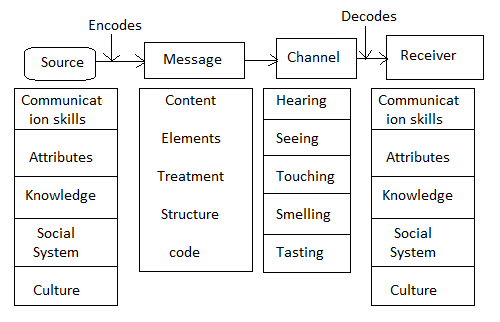
3. Schramm model
Meanwhile, Schramm emphasized in 1954 that when it comes to communications, both senders and receivers alternately act as encoders and decoders.
The following figure shows the model proposed by Schramm.
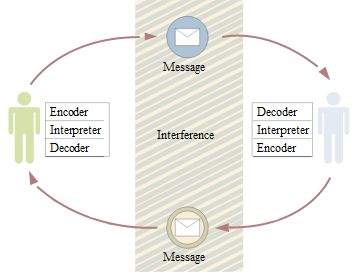
These models are followed by a variety of models, including the "helical" model, Aristotle's model, and a few other models.
You should always keep in mind that each of these models has both strengths and weaknesses. Some communication models try to break down the entire process for clarity, but it's not always as simple as it looks.
There are some complications involved in the communication model. This is one of the things that needs to be carefully understood in the process of understanding how these models work.
Conclusion
It should be remembered that these complications associated with communication models may only understand the tenacity of communication.
It is best for both the source (sender) and the recipient to be clear about what they want to discuss. This is also known as the message context.
This makes it much easier to decipher what the other person is saying without much problem. The process of communication should usually not have too many problems if kept simple and accurate, and the message is easily understood by both parties.
Q4) How can you explain Business Communication Process.
A4) There are other specific characteristics of the business communication process. They are:
1. Integrate part of the management process.
Communication involves communicating the manager's thoughts, opinions and decisions to subordinates of various ranks. It also involves exchanging facts, feelings, suggestions and reactions between your boss and your subordinates.
In this way, communication puts people into action, guides and directs their activities, and regulates and coordinates them for the right work. In this way, managers perform management functions through communication, and managers become communication centers that receive information from various sources and send it to relevant points.
Therefore, communication can be part of the management function and is therefore an integral part of the management process. As such, Chester I. Bernard states, "The first executive function is to develop and maintain a communication system."
2. Two-way traffic:
Communication means not only the descent from the boss to the subordinates, but also both the transmission and the reception. Therefore, when communicating information, the manager needs to know the reaction and the reaction. Otherwise, the instruction and instruction management tasks will be ineffective.
Therefore, one needs to be ready to listen, answer, and interpret, as well as speak, inform, and command. Therefore, communication includes two-way traffic from administrator to worker and from worker to administrator. It will not complete unless the message is correctly understood by the recipient and the response is recognized by the sender.
3. Mutual understanding:
The basic purpose of business communication is to provoke understanding between individuals within an organization. It is an important factor in establishing relationships. By establishing a complete understanding of your subordinates, colleagues, and bosses within your organization, you can be led by a pacemaker and effectively directed by a manager.
The higher you’re understanding in communication, the more likely you are to take action in the direction of achieving your goals.
4. Dissemination:
The subject of business communication covers a wide range, covering all functions such as purchasing, production, sales, finance, recruitment, wages, dividends, market position, innovation and productivity. It also moves all levels of management upwards. Down and sideways. Therefore, business communication is said to be a popular function.
5. Continuity:
Communication is an activity that always exists, without which an organization cannot exist. Communication for tissues is as necessary as blood circulation in the body. Therefore, administrators need to make sure that proper and smooth communication is perfectly directional.
Disruption of communication leads to misunderstandings, the creation of unfavorable attitudes, hostility and conflict. Therefore, communication is a continuous process and requires movement up, down, left and right for all involved to actively participate.
6. Specific:
Business communication is usually specific in nature. This means that a particular communication needs to deal with one subject at a time. This is often necessary for the effectiveness of communication. The variety of subjects in communication can cause dangerous confusion for sound management. You need to be specific with reference to the information that you intend to convey or receive.
7. Result, not cause:
Sound communication is the result of competent management, not its explanation. Business communication is a means to an end and acts as a tool in the hands of managers. The ability of the administrator to handle this tool well depends on its ability. It is not an independent activity, but rather an important element of management function.
So good communication does not produce good managers. But good managers are almost always honest communicators. Misunderstandings in management processes often lead to lack of communication.
8. Internal and external:
Business communication is mainly done in-house. Therefore, it is a neighborhood of administrative functions and is intended for use by members of the organization. Orders, instructions, proposals, and even public notices to announce the company's annual meeting are many examples of internal communication.
But today, much communication moves beyond the horizons of an organization, touching the population on the surface beyond that of an organization (such as advertising). Therefore, business communication can be internal and external.
9. Various types:
There are many types of business communication, including formal, informal, upward, downward, sideways, written, and verbal.
10. Feedback:
Communication cannot be completed without feedback or response. The recipient is formed. Feedback can also be written verbally or gestures. Sometimes mere silence constitutes feedback.
Q5) State the Importance of Communication.
A5) The importance of communication
1. Basics of adjustment
Managers explain to employees the organizational goals, modes of achievement, and interpersonal relationships between employees. This allows for coordination between different employees and departments. Therefore, communication serves as the basis for coordination within the organization.
2. Fluent work
Managers coordinate the human and physical elements of an organization to keep it running smoothly and efficiently. This adjustment is not possible without proper communication.
3. Decision-making foundation
Proper communication provides managers with information to help them make decisions. Without the information, we couldn't make a decision. Therefore, communication is the basis for making the right decisions.
4. Improve management efficiency
Managers communicate goals, give instructions, and assign jobs to subordinates. All these aspects include communication. Therefore, communication is essential for the rapid and effective performance of managers and the entire organization.
5. Increase cooperation and organizational peace
A two-way communication process facilitates cooperation and mutual affection between workers and between workers and management. This reduces friction and leads to peaceful and efficient operation of the factory industry.
6. Increase employee morale
Good communication helps workers adapt to the physical and social aspects of their work. It also improves good relationships in the industry. This boosts the morale of your subordinates and keeps them motivated.
Q6) Write short note on Formal and Informal communication.
A6) (I) Formal communication:
"Formal communication" is the transfer of knowledge or direction in a formal organizational structure. Formal communication maintains the relationship between superiors and subordinates. When a manager tells a deputy manager to perform some tasks, it is an instance of formal communication. Formal communication directs workers to have a clear understanding of what the manager is trying to do, and is usually codified and expressed in writing in manuals, handbooks, newsletters, annual reports, and so on.
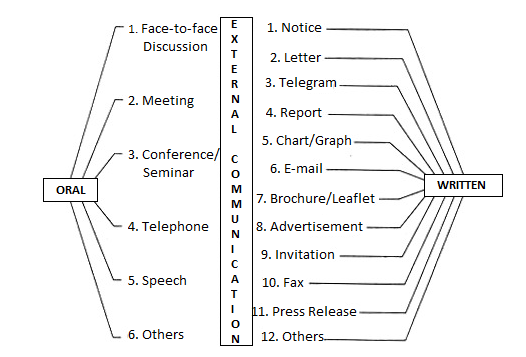
Methods of External Communication
(ii) Informal communication:
"Informal communication" is communication between members of a gaggle or a group, not premised on formal relationships within an organizational structure, but informal relationships between people of equal or different levels. It is premised on understanding. It is referred to as the "grape vine", which represents an informal means of disseminating information and gossip. It does not follow structural routes or processes. It moves in any direction. It's direct, voluntary, flexible, unplanned, and fast-moving.
Q7) Write in your words in Internal and External Communication.
A7) 1. Operation area:
(i) Internal communication:
“Internal communication” can be the process of communication within an organization between superiors and subordinates, colleagues, or between two or more groups. It is formal or informal, oral or written. It flows upwards, downwards, or horizontally, depending on your requirements.
Oral means of communication include face-to-face discussions, verbal instructions, messages, telephone calls, intercoms, conferences, conferences or seminars, and speeches. Written methods include notifications, circulations, notes, reports, charts or graphs, and bulletin boards, Email, fax, etc.

Methods of Internal Communication
(ii) External communication:
Business organizations need to communicate with external agencies such as customers, suppliers, investors, other establishments, banks, insurance companies and government agencies. Such communications are sometimes referred to as "external communications" because their business domain is with people. Outside the organization.
International business organizations have come to communicate with foreign individuals, government agencies / organizations, and more. Oral external communications are formed through face-to-face discussions, meetings, conferences, seminars, telephone calls, speeches, and more. Written processes include notifications, letters, telegrams, reports, emails, advertisements, faxes, handouts and more.
Q8) Describe communication according to the direction.
A8) According to the direction:
(I) Vertical communication:
The flow of upward and downward communication constitutes "vertical communication". In such communications, messages and information are sent from higher-level agencies to their subordinates and vice versa.
(A) Downward communication:
Downward communication refers to the flow of data or understanding from high-ranking people to low-level people. I. In an organization, lower-level people have a high degree of fear and respect for such communication, and as a result, that communication is highly acceptable.
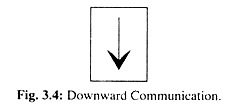
Downward communication
(B) Upward communication:
Communication is claimed to be positive when moving from a subordinate to a boss. Reports and suggestions, opinions and attitudes, complaints and complaints fall into this category. "Upward communication" is less common because it is less preferred by top managers due to its cumbersome and complex nature.

Upward communication
(ii) Horizontal communication:
"Horizontal or sideways communication" is between two subordinates or head at the same level and under the same boss. This is especially important in large or decentralized organizations. Staff can help communicate information between positions and units at comparable levels.

Horizontal communication
(iii) Diagonal communication:
Communication between executives or employees in different departments is called "diagonal communication." There is no clear direction. Upward, downward, and horizontal communication takes place. Both verbal and written means of communication are used. It's mostly informal. There is a good relationship between subordinates and bosses. It's very helpful in solving problems and avoiding conflicts, but it's likely to spread rumors.
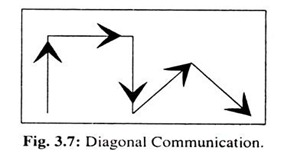
Diagonal communication
Q9) Define Oral communication.
A9) "Verbal or verbal communication" means the transmission of spoken commands, messages, or suggestions. It is done face-to-face or through a speaking instrument such as a telephone.
Oral communication may occur directly between one person and another or in a group, or indirectly through a meeting or conference. No matter which tool you use, it saves you a lot of time and allows for personal contact. It fosters a friendly and supportive spirit, ensures quick understanding and proper explanation, encourages questions and answers, and stimulates interest.
The speaker is also in a position to understand the reaction of the listener. Again, it's perfect for confidential urgent discussions. However, it is not suitable if the space between the speakers and the listener is too long. It is also inappropriate if the message to be communicated is long and reaches many people at the same time. Also, there is a lack of recorded evidence and future references, and listeners do not have much time to think, act, and react.
Q10) What is the different forms of Communication?
A10) There are eight forms of communication
- Within an individual:

Within an individual is a term that describes communication within your inner being. What exactly does that mean? Well, it basically refers to the way you talk to yourself. Self-talk includes actions such as thoughts you think, recitation affirmations, and mental notes made throughout the day.
2. Interpersonal relations:
Interpersonal relationships are interactions with two or more people. Therefore, interpersonal communication involves communication between two or several people. This is one of the most easily identifiable forms of communication, as it exists at almost every moment of our daily lives.


3. Via computer:
The term brings together all forms of communication between people. Computer communication allows people to chat on social networks such as email, text messages, blogs, instant messaging, tweets, or Facebook snapshots. All of these forms are used in the social and business world. Today, many Americans do not communicate face-to-face. Because they find it much more convenient to keep up with the latest gossip and do work-related businesses on computers.
4. Interview:
The interview includes a question-and-answer session. Through interviews, you can learn about other people and their knowledge of many things.
5. Small group:
Communication in groups of 5-10 people is considered small group communication. As students, we often encounter this kind of communication in the classroom, especially when working on group projects. Small group communication is less personal than interpersonal communication, but both utilize the same basic skill set.

6. Speak in public:
Speaking in public is communication between the speaker and the audience.
When speaking in public, it can range from two to hundreds. It is the speaker's job to inform and persuade the audience what he or she is trying to sell / market through public speaking. The picture below is an example of what it looks like to speak in public.
7. Mass:
The media is the largest form of communication. This includes sending a message from one source to many recipients.
Rock bands are very good as a mass communicator. Many of the messages they write and send through musical melodies have saved and changed lives.
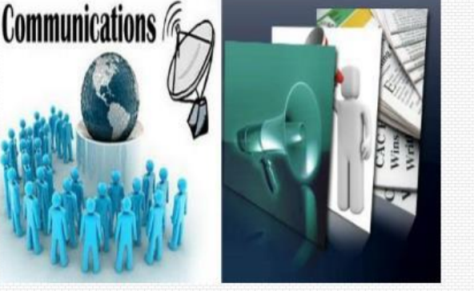
8. Organization:
Organizational communication refers to the various forms of communication that occur within an organizational setting between members. The setting can be a multi-level company in a big city or a bakery in a small town. Organized communication is an important aspect of any business, regardless of location.
Q11) What are the Barriers to Communication?
A11) There are multiple barriers to the communication process. The intended communiqué is often disturbed and distorted, resulting in confusion and communication failure. There are many different types of effective communication barriers: linguistic, psychological, emotional, physical and cultural. All these types are described in detail below.
1. Language barrier
Barriers are one among the foremost restrictive barriers to effective communication. Language is that the most ordinarily used communication tool. The fact that each one major region has their own language is one among the barriers to effective communication. Communication may not be successful even if the dialect is thick.
According to some estimates, the dialects of the two regions change within a few kilometers. Even in the same workplace, different employees have different language skills. As a result, organization-wide communication channels suffer from this.
Therefore, with this barrier in mind, different employees should be given different considerations. Many of them are very fluent in certain languages, and others are accustomed to these languages.
2. Psychological barriers
There are various mental and psychological problems that prevent effective communication. Some people suffer from stage phobias, speech disorders, phobias, depression, and more. All of these conditions are very difficult to manage and can limit the ease of communication.
3. Emotional barriers
An individual's emotional IQ determines the convenience and luxury of communication. Emotionally mature individuals are ready to communicate effectively. On the contrary, those who inherit emotions face some kind of difficulty.
The perfect combination of emotions and facts is important for effective communication. Emotions such as anger, frustration, and humor can obscure an individual's decision-making ability and limit the effectiveness of communication.
4. Physical barriers to communication
They are the foremost obvious barriers to effective communication. These barriers, at least in principle, are almost easy to remove. These include barriers such as noise, door closures, equipment failures used in communications, and cabin closures. In large offices, the mixture of physical separation between different employees and failed equipment can create serious barriers to effective communication.
5. Cultural barriers to communication
As the world becomes more and more global, every large office can have people from some parts of the world. Different cultures have a special impact on some of the basic values of society. Clothing, religion, or lack of them, food, drinks, pets, and therefore general behavior, vary dramatically from culture to culture.
Therefore, these different cultures need to be considered when communicating. This is what we call culturally appropriate. Many multinationals offer special courses at the orientation stage to help people understand other cultures and learn how to be polite and tolerant of other cultures.
6. Structural barriers to the organization
As we've seen, there are some ways to speak at the organizational level. Each of those methods has its own problems and constraints, which are barriers to effective communication. Most of these barriers result from incorrect information and lack of proper transparency available to employees.
7. Attitude barrier
Certain people want to be left alone. They are people who are introverted or simply not sociable. Others are sociable and sometimes want to cling to extra! Both of these cases can be barriers to communication. Some people have attitude problems such as huge ego and unfriendly behavior.
These employees can cause serious tension within the communication channels in which they exist. Certain personality traits such as shyness, anger, and social anxiety can also be eliminated through courses and proper training. However, issues such as egocentric behavior and selfishness may not be fixed.
8. Perceptual barrier
Different people have different perceptions of similar things. This is often an incontrovertible fact that must be taken under consideration within the process of communication. Knowledge of the audience's perceptual level is important for effective communication. All messages or communiqués should be simple and clear. There should be no room for various interpretations.
9. Physiological barriers
Certain disorders, illnesses, or other restrictions also can impede effective communication between different channels of a corporation. High-pitched voice, dyslexia, etc. are some samples of physiological barriers to effective communication. However, these are not important as they can be easily modified and removed.
10. Technical Barriers and Social Religious Barriers
Other barriers include technical barriers. Technology is evolving rapidly, and as a result, it's difficult to stay up with the newest developments. Therefore, technological advances can be a barrier. In addition to this the cost of technology is usually very high.
Q12) ‘‘Communication is two-way process.” Explain
A12) Simple transmission of the message by the sender does complete unless t e receiver understood the message properly and sends back his response to the sender. Thus, it is a two-way process.
Communication is a process of transmission of message, news, orders, requests, ideas etc. The term ‘communication has been derived from Latin word “Communis’ or ‘Communicator’ which means to make common’. Thus, communication is the exchange of facts, ideas, messages, requests, orders etc. between two or more persons. It has been defined as under:
“Communication is an exchange of facts, ideas, opinions or emotions by two or more persons.” -Newman and Summer.
“Communication is an exchange of facts, ideas, opinions or emotions by two or more persons.” -George R. Terry
“Communication is the sum of all the things which a person does what he wants to create understanding in the mind of another. It involves a systematic and continuous process of telling, listening and understanding.” -Locus A. Allen
To conclude, Communication is the transfer of information from one person to another. It is the process of imparting ideas so that organisational objectives may be achieved.
Characteristics of business communication
- Communication is an exchange of facts, ideas and opinions from one person to another. (Introduction to Business Communication Question Answers)
- Communication is a continuous process and not a specific function.
- Communication is a two-way process. It is incomplete without feedback.
- Communication is a universal process. It is required at all levels, in all fields and at all times.
- Communication is a managerial function. It is required at all levels right from planning to control.
Q13) What are the functions of Business Communication?
A13) Objectives or functions of business communication may broadly, be divided into two parts:
(I) Internal Functions, and (II) External Functions
I. Internal Objective or Functions of Business Communication
- To provide Information to Management: Business communication is to provide all important facts and information to man business. It helps them in taking appropriate business decisions.
- To provide Information to Employees: Business communication conveys the feelings, attitude, orders, and decisions of management to employees. It helps in creating harmonious business environment.
- To Establish Co-ordination: Communication helps in establishing effective co-ordination among different departments, activities and employees It helps in creating mutual faith and trust.
- To improve Morale: Communication helps employees in realising their rights, duties, place and role. It keeps them informed about business policies and decisions. It helps in increasing efficiency as well.
II. External Objectives or Functions of Business Communication
- To Maintain Relations with Suppliers: Communication helps in communicating orders, requirements, problems and complaints to suppliers. It helps in getting goods and services regularly and smoothly.
- To Maintain Relations with Customers: Communication helps in maintaining and developing relations with customers. It helps in increasing sales and profit.
- Base of Advertisement: Communication is the base of advertising. It helps in developing and increasing the image of products and enterprise.
- Report to Owners and Other Parties: Communication provides all relevant information to owners, banks, government authorities and economic world.
Q14) Explain the concepts of Non-verbal and verbal communication.
A14) Meaning of communication
Communication is an exchange of information, facts, opinions, ideas, etc. between two or more persons. It is a process which involves an exchange of business information with a view of achieving organizational objectives.
Forms of Communication: There are three forms of communication: (a) Non-verbal, (b) Verbal, and (c) Written.
(A) non-verbal communication or gestural communication
Meaning of Non-verbal Communication
The term ‘non-verbal’ means ‘without words. Thus, non-verbal communication is the communication in which no words are used. The person who wants to communicate some messages to another, uses his expressions (body language). The other person (receiver) visualizes as to what the first person is trying to communicate. There are two effective ways of non-verbal communication:
(i) Use of some signals such as traffic lights, pictographs, sirens, telephone rings, etc.
(ii) Use of body language such as nodding or shaking the head, gritting the teeth, raising eyebrows, pointing thumb or finger, raising hands, smiling, glaring, clapping, etc. Non-verbal communication is known as gestural communication also. (BCom Introduction to Business Communication Question Answers)
Functions of Non-verbal Communication
According to Thill and Bovee, non-verbal communication has six functions:
- To provide information.
- To regulate the flow of conversation.
- To express emotions.
- To Complement, contradict or expand verbal messages.
- To control or influence others.
- To complete verbal message.
Advantages of Non-verbal Communication
- Reliability: An important advantage of non-verbal communication is its reliability. It is easy to understand the emotions and feelings of speaker by his facial expressions. Body language speaks more than words.
- Economic: Non-verbal communication is most economical. It involves no expenditure.
- Personal Influence: Non-verbal communication is quite effective because it carries personal influence of speaker also.
- Quickness: Non-verbal communication is the quickest form of communication. Since, both the sender and receiver are in front of each other, it takes no time.
- Accurate Understanding: It is easy to understand and interpret the message in this form of communication. Body language speaks the attitudes and intentions more accurately. It helps in developing better understanding,
Disadvantages or Limitations of Non-verbal Communication
- Lack of Secrecy: It is difficult to maintain secrecy in this form of communication because expressions or gestures are seen by other persons also.
- Possibility of Misunderstanding: If the receiver fails to understand the message, it may create misunderstanding between the parties.
- Necessity of Physical Presence: Non-verbal communication can be possible only if both the parties are present facing each other. It cannot be used if they are at different places.
- Lack of Proof: An important disadvantage of non-verbal communication is that there is no written proof of the message. It may create a lot of problems in case of future disputes.
- Suitable Only for Brief Messages: Non-verbal communication is suitable only if the message is brief.
- Not Suitable for Past Events: Non-verbal communication is suitable only for the present and not for the past events and ideas.
Meaning of Verbal or Oral Communication
The term ‘verbal’ means anything relating to ‘mouth’. Thus, verbal or oral communication is the form of communication in which a message is transmitted in spoken words. In the process of verbal communication, the sender and receiver exchange their messages either through face-to-face communication or through some mechanical device. It may take place in different ways such as personal talks, telephonic talks, interviews, seminars, public speeches etc.
Levels of Verbal or Oral Communication
- Face to Face Communication: It is the first and most common level of verbal communication. In this form, both the receiver and sender of message are face to face with each other. Exchange of messages is done with the help of oral words. In this process, receiver of message comes to know the body language of sender also
- Use of Device: In this form of verbal communication, the sender of message uses some mechanical or electrical device such as telephone, mobile, internet, etc. Both the sender and receiver of message complete their communication on the spot. (Introduction to Business Communication Question Answers)
Channels of Verbal Communication
- Face to Face Discussion: It is the simplest and most effective form of verbal communication. In this form, both the sender and receiver of message exchange their views and ideas.
- Meetings and Conferences: In this form, a meeting is called of all persons concerned with the issue.
- Speeches: When the persons to be addressed on an issue, are in large number, communication may take place in the form of speech. In business chairman may speak to shareholders, supervisor may speak to workers, leader may speak to followers, etc.
- Training and Refresher Courses: In this form of verbal communication, newly appointed employees are trained for their work employees are trained through refresher courses so that they may come to the modern and latest techniques.
- Interviews: This form of communication is very common at the time of selection of new employees. Candidates seeking for the job are called for personal interview. Their ability and skill are tested through interview.
- Telephone and Internet: If the receiver and sender of message are living at different places, the best way of oral communication is to talk on telephone and internet. Both the parties complete their communication and get their doubts clear.
- Radio and Television: Different information are conveyed to listeners through radio and television also. In business, it is growing as the most popular media of advertisement. (Introduction to Business Communication Question Answers)
- Grapevine: Grapevine means informal communication from one person to another, another to many others and so on. It takes place generally with regards to unofficial information.
Advantages of Verbal or Oral Communication
- Saving of Time: Verbal communication is the most popular form of communication because it takes almost no time. It helps in quick decision making
- Saving of Money: Verbal communication is very economic. In face-to-face communication, no expenses are involved. Communication through telephone and internet is also very economic.
- Personal Touch: Verbal communication is very effective because of personal touch. Both the sides can understand each other fully and clearly being face to face. It helps in developing mutual faith and confidence.
- Effective Communication: Verbal communication is very effective. It carries more weight in some cases because words are more effective than letters.
- Flexibility: Oral communication is quite flexible because it can be changed according to situation. Flow of language, style of presentation and mode of instructions can be changed according to need and circumstances.
- Participative Management: Oral communication promotes participative management. All persons concerned with an issue are invited to discuss it and take appropriate decisions.
- Democratize Leadership: Oral communication promotes democratise leadership. Supervisors and managers can encourage and inspire their subordinates. (Introduction to Business Communication Question Answers)
- Delegation of Authority: Oral communication is helpful in the delegation of authority. Executives may delegate their authority to their subordinates and may inspire them to accept the challenge.
Disadvantages or Limitations of Verbal Communication
- Presence of Both Parties: Oral communication is possible only when the both parties are present. If receiver is not available, sensity of oral communication is lost.
- Not Suitable for Lengthy Messages: Oral communication is suitable only if the message is short because it is very difficult to remember and recall long messages.
- Lack of Proof: An important limitation of verbal communication is that there is no proof of communication. Either party may change it. Therefore, it cannot be used for future references.
- Possibility of Misinterpretation: In oral communication, there is a possibility of misinterpretation. Either party may present the facts in twisted form.
- Not Suitable for Policy Matters: Oral communication is not suitable for policy matters and important decisions because of lack of proof.